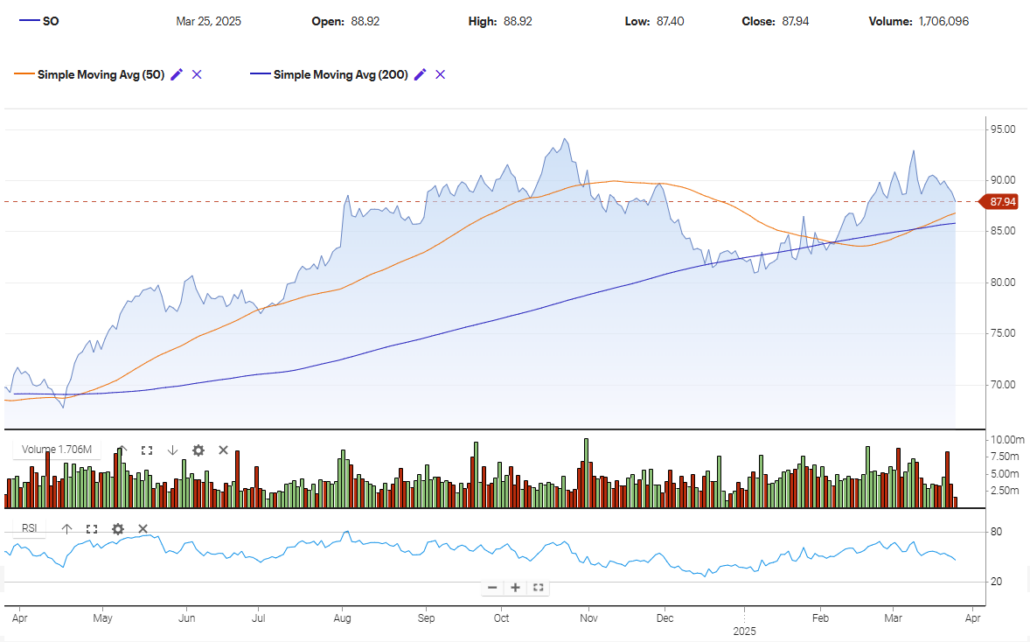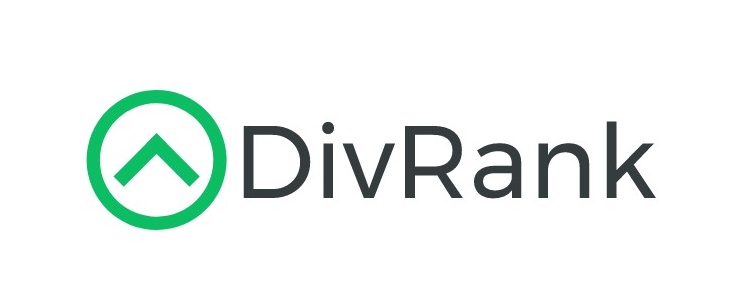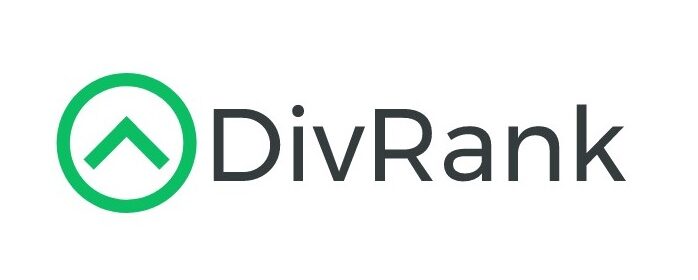Updated 3/26
Southern Company, known by its ticker SO, is one of the nation’s largest utility providers, serving millions of customers throughout the southeastern United States. Through subsidiaries like Georgia Power and Alabama Power, it delivers electricity and natural gas across a wide region, offering a level of predictability and stability that’s tough to find elsewhere. For income-focused investors, especially those building portfolios for reliable dividends, SO has long been a staple.
Recent Events
Over the past year, Southern Company has seen a strong rebound. The stock is currently hovering near $89, reflecting a 24% gain over the last 12 months—quite a jump for a utility, considering the S&P 500 only gained around 8% during the same time.
Much of that upside came as the long-delayed Vogtle nuclear project neared completion. The successful launch of Unit 4 marked the end of a saga that had plagued the company with cost overruns and construction delays for years. Now that this major capital drain is in the rearview, the business is shifting gears from heavy spending to more predictable, stable operations. That’s a welcome transition for dividend investors who care about cash flow more than headline-making expansion.
Key Dividend Metrics
📈 Forward Dividend Yield: 3.23%
💵 Annual Dividend: $2.88 per share
📅 Payout Ratio: 71.7%
🔁 5-Year Dividend Growth: Around 3.3% annually
📊 Consecutive Years of Increases: 22
🏦 Next Ex-Dividend Date: February 18, 2025
📆 Next Dividend Pay Date: March 6, 2025
Dividend Overview
Southern Company continues to deliver a solid stream of dividend income to shareholders. With a forward yield of 3.23%, it’s not the highest-yielding stock out there, but it’s dependable. The current dividend of $0.72 per quarter translates to an annual payout of $2.88.
What stands out more than the yield itself is the consistency. Southern has paid—and raised—its dividend every year for more than two decades. That’s the kind of track record that builds trust, especially for those relying on dividends for retirement income or portfolio stability.
Dividend Growth and Safety
Dividend growth here is slow and steady. Over the past five years, the annual increase has averaged just over 3%. While that’s not going to knock anyone’s socks off, it keeps pace with inflation and gives investors a little extra income each year.
The payout ratio is sitting around 72%, which is reasonable for a utility. It’s a high number compared to some sectors, but for regulated utilities with predictable earnings, it’s perfectly normal. Southern’s consistent earnings base allows it to maintain this level without much strain. The combination of solid cash flow and regulatory support makes this dividend look quite safe by utility standards.
Chart Analysis

Market Cycle Phase
Looking at the Southern Company (SO) chart, the broader picture appears to reflect a completed markup phase that peaked around early November, followed by a clear distribution phase, then a markdown into late December, and now a gradual recovery that may be signaling a transition into early accumulation again.
The strong run-up from spring through early fall last year fits well with the markup behavior — steady higher highs, increasing volume in key breakout moves, and consistent support above the 50-day moving average. By October and November, the stock was showing signs of topping, as price action started to flatten and volume became choppier with more frequent reversals. That was the telltale distribution zone.
Following that, the drop into late December happened on a rising volume profile, confirming markdown behavior. It found its footing right above the 200-day moving average, which has acted as a long-term support level. Since then, the price action has slowly started building back up, carving out a series of higher lows.
Moving Averages
The 50-day moving average crossed below the 200-day around mid-January, a classic death cross. But that bearish signal has started to fade, with the 50-day curving upward and now nearly converging with the 200-day again. Price is hovering right around both moving averages, so this is a pivotal zone. If the stock can hold above this band and the 50-day crosses back above the 200-day, it would mark a technical shift back toward strength.
Volume Behavior
Volume tells a subtle but important story here. During the downtrend in late 2024, red bars outweighed green, especially on sharp sell days. But more recently, the volume profile has become more balanced. Some of the stronger green days in February and early March were accompanied by above-average volume, hinting at institutional interest creeping back in.
However, the most recent five sessions have shown volume trailing off, suggesting a bit of indecision. It’s not heavy selling, but it also doesn’t reflect strong buying conviction yet.
RSI and Momentum
The Relative Strength Index (RSI) dipped into oversold territory back in late December, bottoming out under 30. That marked the beginning of the current recovery phase. Since then, RSI has been climbing in a controlled fashion, peaking near 60 earlier this month, and now gradually easing back.
It’s not showing overbought conditions, but the decline in RSI while price hovers at resistance is something to watch. It may be signaling that momentum is cooling, even if price hasn’t broken down yet.
Candlestick Action
The last five candles paint a picture of short-term hesitation. Most have small real bodies and longer upper wicks, indicating that buyers are trying to push price up intraday but sellers keep stepping in before the close. The March 25 candle in particular shows a reversal pattern — opening and hitting the high of day early, then fading into the close.
These wick-heavy candles near the 50/200-day moving average cluster suggest this is a zone of congestion, and the stock will need strong volume to punch through.
Overall, SO seems to be testing the early stages of another markup attempt, but momentum has paused right at a technical inflection point.
Analyst Ratings
South Plains Financial, Inc. (SPFI) continues to draw positive sentiment from analysts, with a consensus buy rating and an average 12-month price target of $42.67. This points to a healthy upside from current levels, driven by the bank’s consistent earnings performance and strong balance sheet.
Recent analyst actions include:
📈 January 27, 2025 – Keefe, Bruyette & Woods reaffirmed their outperform rating, slightly adjusting their price target from $46.00 to $45.00. The minor revision reflects updated forecasts but overall confidence in SPFI’s core banking operations remains strong.
🚀 January 27, 2025 – Hovde Group also maintained an outperform rating and bumped their target from $46.00 to $47.00. Their revised outlook was based on the company’s robust net interest margin and effective cost control measures, which have outperformed peer averages.
💼 July 23, 2024 – Piper Sandler reiterated a buy rating, lifting the price target from $32.00 to $36.00. This upgrade was driven by expectations of continued loan growth and stable credit quality, particularly in SPFI’s Texas footprint.
📊 January 29, 2024 – Raymond James kept their outperform rating in place and raised the price target from $28.00 to $31.00. Analysts cited improving earnings visibility and a more favorable interest rate outlook as key drivers.
🔄 July 26, 2023 – Keefe, Bruyette & Woods had earlier reaffirmed their outperform call but lowered the price target from $30.00 to $28.00, reflecting caution around macroeconomic conditions at the time. Despite the slight pullback, the long-term view remained constructive.
Analysts across the board are recognizing SPFI’s disciplined lending approach, strong liquidity position, and improving return metrics. While some price targets have seen small adjustments, the overall tone remains upbeat and reflects confidence in the bank’s ability to keep delivering value to shareholders.
Earnings Report Summary
A Mixed Finish to the Year
Southern Company wrapped up 2024 with a bit of a mixed bag. The fourth quarter didn’t quite match up to the same stretch the year before, with earnings landing at $534 million, or 49 cents per share. That’s a step down from the $855 million, or 78 cents per share, they posted in Q4 of 2023. Still, when you zoom out and look at the full year, the picture improves quite a bit.
Full-Year Growth Holds Up
For all of 2024, the company brought in $4.4 billion in earnings, which worked out to $4.02 per share. That’s up from $4 billion and $3.64 per share in 2023, so even with a softer quarter to close things out, Southern Company managed to grow the bottom line over the course of the year.
On an adjusted basis, the story is similar. Adjusted earnings for the fourth quarter came in at $544 million, or 50 cents per share, compared to $700 million, or 64 cents, in the same period the year before. For the full year, adjusted earnings climbed to $4.4 billion, or $4.05 per share—again, an improvement from the prior year.
Revenue Keeps Climbing
Revenue showed steady progress. In Q4, Southern pulled in $6.3 billion in operating revenue, up nearly 5% from $6 billion the year before. Full-year revenue landed at $26.7 billion, which is a 5.8% increase over 2023’s $25.3 billion. That kind of growth is encouraging for a utility company, especially in a higher-rate environment.
Looking Ahead
Leadership called out the contributions of their workforce and the company’s focus on long-term value creation. There’s a clear sense of forward momentum, even as the company deals with the usual push and pull of rate cases, capital projects, and regulatory shifts.
So while the fourth quarter wasn’t a blockbuster, the year as a whole moved in the right direction. Southern Company continues to deliver reliable earnings and revenue growth, which is exactly what investors tend to look for in a name like this.
Financial Health and Stability
Southern’s balance sheet is a bit of a mixed bag. On the plus side, its operating margin is near 19%, and return on equity is pushing 12%, which speaks to efficient operations and good use of capital. Cash from operations came in at nearly $9.8 billion over the past year, a healthy number that supports both dividends and basic investment in infrastructure.
On the flip side, debt is high—over $66 billion, with a debt-to-equity ratio above 180%. That’s significant. It’s not necessarily alarming for a utility, but it does mean Southern is sensitive to changes in interest rates. The current ratio of 0.67 also signals limited short-term liquidity. None of this is out of the ordinary for a utility company, but it’s worth keeping an eye on, particularly in a rising rate environment.
The good news is that Southern operates under a regulated structure, so revenue and returns are more predictable than most sectors. The bond market still treats it as a safe bet, and as long as regulators remain cooperative, that stability should continue.
Valuation and Stock Performance
At a price-to-earnings ratio just over 22, Southern isn’t exactly cheap. But it’s not overpriced either when viewed in the context of the broader utility space, which has seen some premium valuations lately due to investor demand for yield.
What’s notable is the stock’s recent strength. It’s climbed more than 24% in the past year and is currently trading well above its 50- and 200-day moving averages. That signals strong investor interest and momentum, even in a sector that’s typically viewed as sleepy.
The PEG ratio is around 3.0, which tells you growth expectations are limited. But that’s expected here. This is about income, not explosive growth. What investors are paying for is consistency and a reliable dividend—not big surprises.
Risks and Considerations
There are a few areas dividend investors should be mindful of when looking at Southern.
First, there’s the matter of interest rates. With such a large debt load, rising borrowing costs could impact earnings down the road. Plus, as yields elsewhere rise, the appeal of a 3% dividend diminishes a bit—especially if the stock isn’t growing fast.
Second, this is a regulated utility, so a big chunk of its profitability depends on state-level decisions. If regulators turn less favorable toward rate increases or disallow certain capital recoveries, that could eat into returns.
Third, while the Vogtle nuclear project is mostly behind them, capital spending is far from over. The company is investing heavily in clean energy, grid modernization, and other infrastructure—good for the long term, but a continued drag on free cash flow in the short term.
Finally, the broader energy transition brings some unknowns. While Southern is moving into renewables, the speed and cost of that shift could pose challenges—particularly if public policy, technology, or customer demand changes faster than expected.
Final Thoughts
Southern Company isn’t the kind of stock that dominates the headlines, and that’s exactly why many dividend investors like it. It offers steady income, a long history of payout increases, and the kind of business model that hums along quietly while delivering value year after year.
With the Vogtle project largely in the past, the company is now in a stronger position to focus on operations and shareholder returns. The yield may be a little lower than its historical average, but the consistency of the dividend—and the company’s commitment to raising it—still makes it a solid holding for anyone building an income-focused portfolio.
Southern doesn’t promise explosive returns, but it delivers on what matters to dividend investors: predictability, safety, and a check in the mail every quarter.

